机器学习(六):回归分析——鸢尾花多变量回归、逻辑回归三分类只用numpy,sigmoid、实现RANSAC 线性拟合
[实验1 回归分析]
一、 预备知识
- 使用梯度下降法求解多变量回归问题

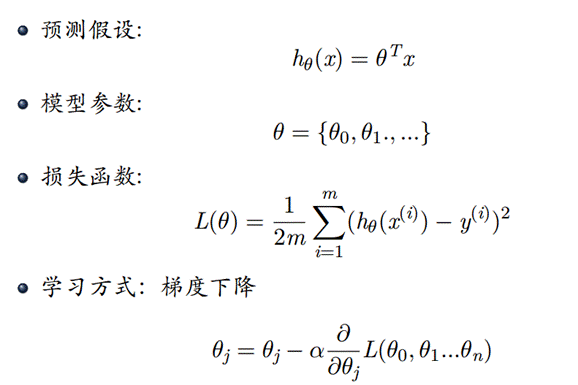
- 数据集
Iris 鸢尾花数据集是一个经典数据集,在统计学习和机器学习领域都经常被用作示例。数据集内包含 3 类共 150 条记录,每类各 50 个数据,每条记录都有 4 项特征:花萼长度、花萼宽度、花瓣长度、花瓣宽度,可以通过这4个特征预测鸢尾花卉属于(iris-setosa, iris-versicolour, iris-virginica)中的哪一品种。
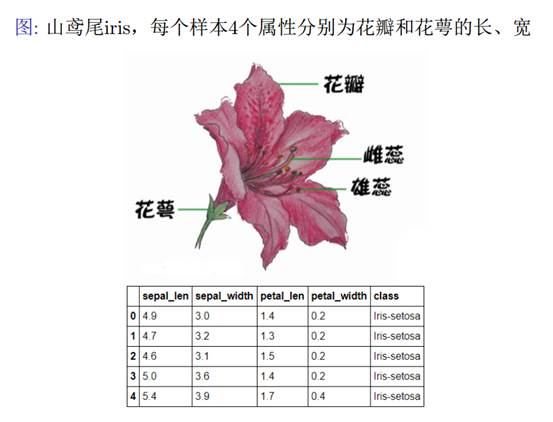
sepal length:花萼长度,单位cm;sepal width:花萼宽度,单位cm
petal length:花瓣长度,单位cm;petal width:花瓣宽度,单位cm
种类:setosa(山鸢尾),versicolor(杂色鸢尾),virginica(弗吉尼亚鸢尾)

我们用100组数据作为训练数据iris-train.txt,50组数据作为测试数据iris-test.txt。
'setosa' 'versicolor' 'virginica'
0 1 2
二、 实验目的
-
掌握梯度下降法的原理及设计;
-
掌握利用梯度下降法解决回归类问题。
三、 实验内容
数据读取:(前4列是特征x,第5列是标签y)
import numpy as np
train_data = np.loadtxt('iris-train.txt', delimiter='\t')
x_train=np.array(train_data[:,:4])
y_train=np.array(train_data[:,4])
- 设计多变量回归分析方法,利用训练数据iris-train.txt求解参数
思路:首先确定h(x)函数,由于是4个特征,我们可以取5个参数
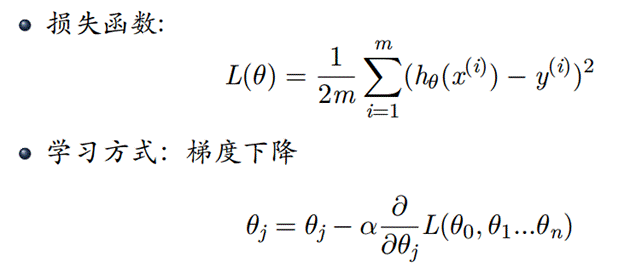
- 设计逻辑回归分析方法,利用训练数据iris-train.txt求解参数
思路:首先确定h(x)函数,由于是4个特征,我们可以取5个参数

- 利用测试数据iris-test.txt,统计逻辑回归对测试数据的识别正确率 ACC,Precision,Recall。
四、 操作方法和实验步骤
1.对于多变量回归分析:
(1)实现损失函数、h(x)、梯度下降函数等:
def hypothesis(X, theta):
return np.dot(X, theta)
def cost_function(X, y, theta):
m = len(y)
J = np.sum((hypothesis(X, theta) - y) ** 2) / (2 * m)
return J
def gradient_descent(X, y, theta, alpha, num_iters):
m = len(y)
J_history = np.zeros(num_iters)
for i in range(num_iters):
theta = theta - (alpha / m) * np.dot(X.T, (hypothesis(X, theta) - y))
J_history[i] = cost_function(X, y, theta)
return theta, J_history
(2)处理输出X并开始计算
X_train_hat= np.hstack((np.ones((X_train.shape[0], 1)), X_train))
X_train= X_train_hat
theta = np.ones(X_train.shape[1])
alpha = 0.0005
num_iters = 120
theta, J_history = gradient_descent(X_train, y_train, theta, alpha, num_iters)
print("Parameter vector: ", theta)
print("Final cost: ", J_history[-1])
- 对于逻辑回归分析
import numpy as np
from sklearn.metrics import classification_report
from sklearn.preprocessing import LabelEncoder
train_data = np.loadtxt("iris/iris-train.txt", delimiter="\t")
X_train = train_data[:, 0:4]
y_train = train_data[:, 4]
encoder = LabelEncoder()
y_train = encoder.fit_transform(y_train) # Convert class labels to 0, 1, 2
X_train_hat = np.hstack((np.ones((X_train.shape[0], 1)), X_train))
X_train = X_train_hat
def sigmoid(z):
return 1 / (1 + np.exp(-z))
def cost_function(X, y, theta):
m = len(y)
epsilon = 1e-5
h = sigmoid(np.dot(X, theta))
J = (-1 / m) * np.sum(y * np.log(h+epsilon) + (1 - y) * np.log(1 - h+epsilon))
grad = (1 / m) * np.dot(X.T, (h - y))
return J, grad
def gradient_descent(X, y, theta, alpha, num_iters):
m = len(y)
J_history = np.zeros(num_iters)
for i in range(num_iters):
J, grad = cost_function(X, y, theta)
theta = theta - (alpha * grad)
J_history[i] = J
return theta, J_history
def logistic_regression(X, y, alpha, num_iters):
theta = np.ones((X_train.shape[1], 3))
# Perform gradient descent to minimize the cost function for each class
for i in range(3):
y_train_i = (y_train == i).astype(int)
theta_i, J_history_i = gradient_descent(X_train, y_train_i, theta[:, i], alpha, num_iters)
import matplotlib.pyplot as plt
plt.plot(J_history_i)
plt.xlabel('Iterations')
plt.ylabel('Cost')
plt.title('Cost function'+str(i))
plt.show()
theta[:, i] = theta_i
print(f"Class {i} parameter vector: {theta_i}")
print(f"Class {i} final cost: {J_history_i[-1]}")
return theta
def predict(test_data, theta):
X_test = test_data[:, 0:4]
X_test_hat = np.hstack((np.ones((X_test.shape[0], 1)), X_test))
X_test = X_test_hat
y_test = test_data[:, 4]
y_test = encoder.transform(y_test) # Convert class labels to 0, 1, 2
y_pred = np.zeros(X_test.shape[0])
for i in range(3):
sigmoid_outputs = sigmoid(np.dot(X_test, theta[:, i]))
threshold = np.median(sigmoid_outputs[y_test == i])#不采用统一的阈值,而是采用每个类别的中位数作为阈值
y_pred_i = (sigmoid_outputs >= threshold).astype(int)
y_pred[y_pred_i == 1] = i
y_pred = encoder.inverse_transform(y_pred.astype(int)) # Convert class labels back to original values
print(classification_report(y_test, y_pred))
test_data = np.loadtxt("iris/iris-test.txt", delimiter="\t")
theta = logistic_regression(X_train, y_train, 0.0005, 5000)
predict(test_data, theta)
实验结果和分析
1.对于多变量回归分析的实验结果:
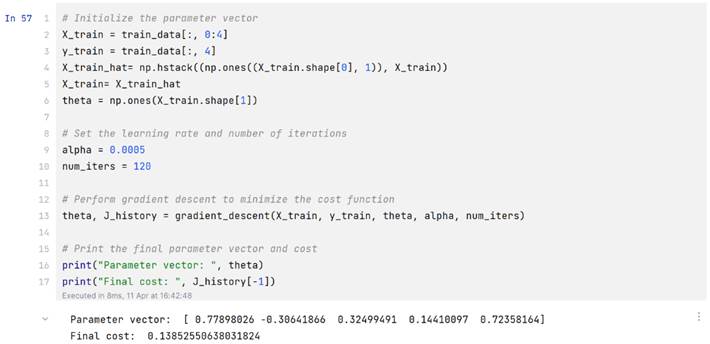
代价曲线:
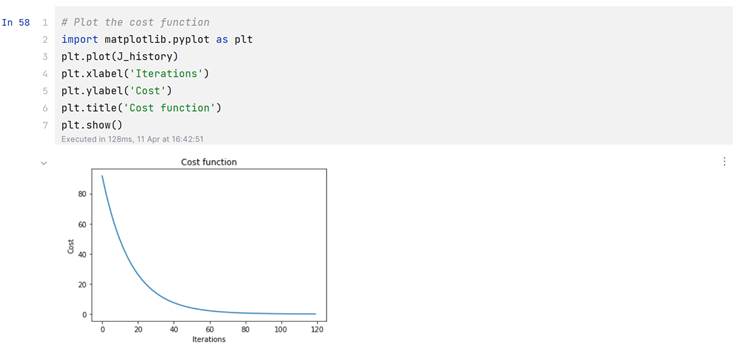
那么计算函数也就是:
2.对于逻辑回归分析的实验结果
代价曲线:


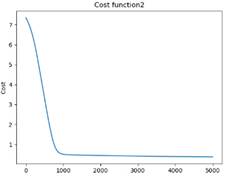
利用测试数据iris-test.txt,统计逻辑回归对测试数据的识别正确率 ACC,Precision,Recall:
通过sigmoid函数实现的逻辑回归只能处理二分类,我是通过分别计算三个二分类实现的。【猜测:预测1时把0和2归为同一类会对模型产生误导】
由于实现方法是One VS One.效果并不是很好,而且得到如下结果还是在处理sigmoid函数结果时还修改了原本0.5的阈值,有泄露结果的嫌疑。
(不采用统一的阈值,而是采用每个类别的h函数结果中位数作为阈值)
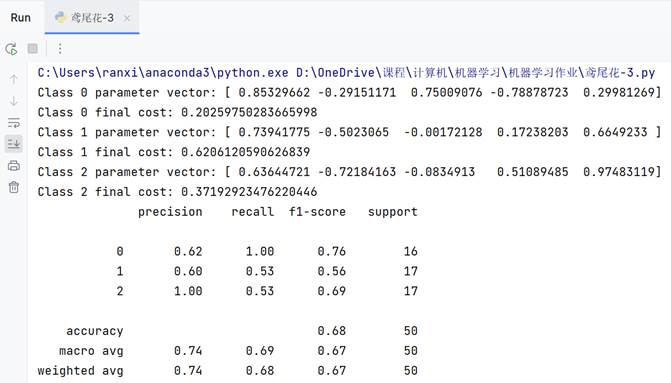
五、 思考题
给出 RANSAC 线性拟合的 python 实现
import random
import numpy as np
from matplotlib import pyplot as plt
def ransac_line_fit(data, n_iterations, threshold):
"""
RANSAC algorithm for linear regression.
Parameters:
data (list): list of tuples representing the data points
n_iterations (int): number of iterations to run RANSAC
threshold (float): maximum distance a point can be from the line to be considered an inlier
Returns:
tuple: slope and y-intercept of the best fit line
"""
best_slope, best_intercept = None, None
best_inliers = []
for i in range(n_iterations):
# Randomly select two points from the data
sample = random.sample(data, 2)
x1, y1 = sample[0]
x2, y2 = sample[1]
# Calculate slope and y-intercept of line connecting the two points
slope = (y2 - y1) / (x2 - x1)
intercept = y1 - slope * x1
# Find inliers within threshold distance of the line
inliers = []
outliers = []
for point in data:
x, y = point
distance = abs(y - (slope * x + intercept))
distance = distance / np.sqrt(slope ** 2 + 1)
if distance <= threshold:
inliers.append(point)
else:
outliers.append(point)
# If the number of inliers is greater than the current best, update the best fit line
if len(inliers) > len(best_inliers):
best_slope = slope
best_intercept = intercept
best_inliers = inliers
outliers = [point for point in data if point not in best_inliers]
# Plot the data points, best fit line, and inliers and outliers
fig, ax = plt.subplots()
# ax.scatter([x for x, y in data], [y for x, y in data], color='black')
ax.scatter([x for x, y in best_inliers], [y for x, y in best_inliers], color='green')
ax.scatter([x for x, y in outliers], [y for x, y in outliers], color='black')
x_vals = np.array([-5,5])
y_vals = best_slope * x_vals + best_intercept
ax.plot(x_vals, y_vals, '-', color='red')
# threshold_line = best_slope * x_vals + best_intercept + threshold*np.sqrt((1/best_slope) ** 2 + 1)
threshold_line = best_slope * x_vals + best_intercept + threshold * np.sqrt(best_slope ** 2 + 1)
ax.plot(x_vals, threshold_line, '--', color='blue')
# threshold_line = best_slope * x_vals + best_intercept - threshold*np.sqrt((1/best_slope) ** 2 + 1)
threshold_line = best_slope * x_vals + best_intercept - threshold * np.sqrt(best_slope ** 2 + 1)
ax.plot(x_vals, threshold_line, '--', color='blue')
# ax.set_xlim([-10, 10])
ax.set_ylim([-6, 6])
plt.show()
return best_slope, best_intercept
import numpy as np
# Generate 10 random points with x values between 0 and 10 and y values between -5 and 5
data = [(x, y) for x, y in zip(np.random.uniform(-5, 5, 10), np.random.uniform(-5, 5, 10))]
print(data)
# Fit a line to the data using RANSAC
slope, intercept = ransac_line_fit(data, 10000, 1)
print(slope, intercept)
结果:



